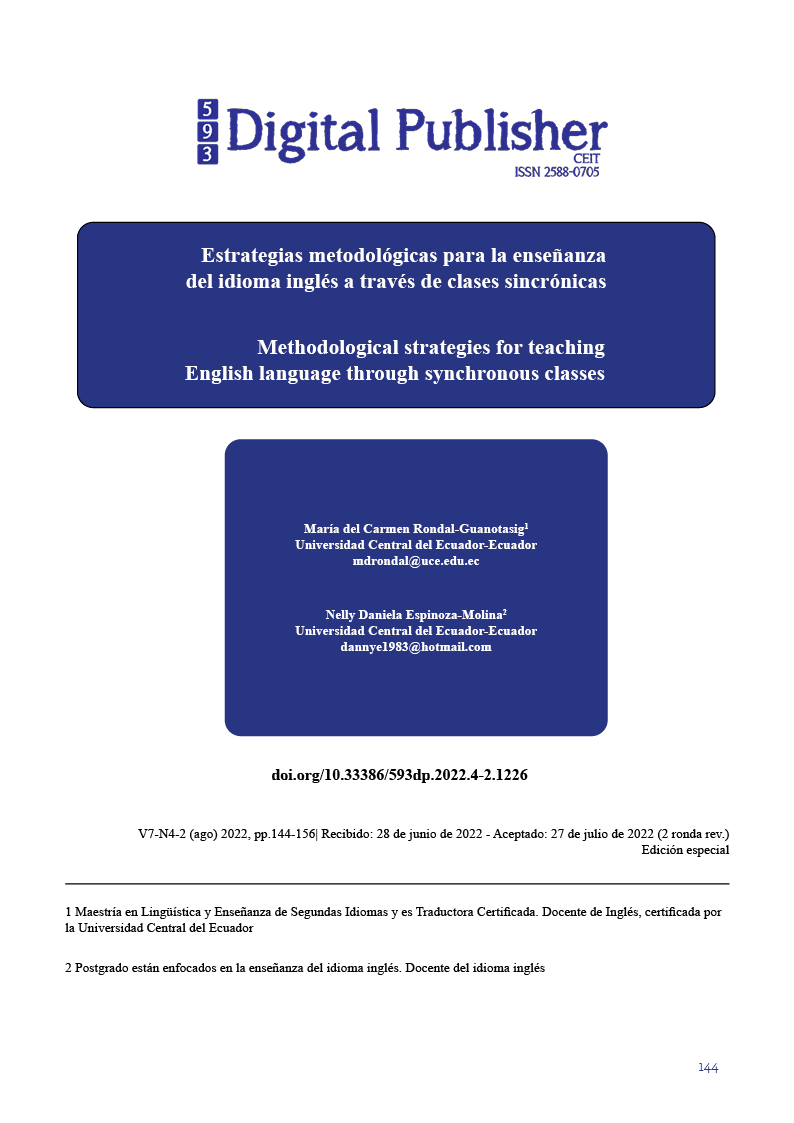Methodological strategies for teaching English language through synchronous classes
Main Article Content
Abstract
Before the effect of the pandemic, students and teachers spent their time online, largely to socialize. They had their own learning spaces, so that they could develop their knowledge independently and under the choice of the group of friends, materials, applications and communication mechanisms. The new conditions imposed by the pandemic encouraged a change in strategies and mentality to maintain the vitality of educational services worldwide. Virtuality gained even more strength, becoming the most viable alternative to achieve a successful teaching-learning process at all levels. The article aims to describe the methodological strategies for teaching the English language through synchronous classes. The methodology applied is qualitative, through a bibliographic review, taking into account that this type of research is based on the collection of data from several authors as the main mechanism. It addresses a review of relevant articles, scientific journals and degree works in the field; that contributed with the application of methodological proposals for the use of virtuality and describes the main ideas on the subject. The main problem was identified as the lack of experience of teachers and students in the use of this type of class. As a result of the research, the wide acceptance that virtual teaching has had in the new scenario imposed by COVID 19 is demonstrated, especially the use of synchronous classes as a technological solution to maintain the necessary interaction between students and teachers with the in order to achieve English language skills in learners. The need to combine synchronous and asynchronous classes was also evidenced in order to take better advantage of virtuality and be able to reach a greater number of students.
Downloads
Article Details

This work is licensed under a Creative Commons Attribution-NonCommercial-ShareAlike 4.0 International License.
1. Derechos de autor
Las obras que se publican en 593 Digital Publisher CEIT están sujetas a los siguientes términos:
1.1. 593 Digital Publisher CEIT, conserva los derechos patrimoniales (copyright) de las obras publicadas, favorece y permite la reutilización de las mismas bajo la licencia Licencia Creative Commons 4.0 de Reconocimiento-NoComercial-CompartirIgual 4.0, por lo cual se pueden copiar, usar, difundir, transmitir y exponer públicamente, siempre que:
1.1.a. Se cite la autoría y fuente original de su publicación (revista, editorial, URL).
1.1.b. No se usen para fines comerciales u onerosos.
1.1.c. Se mencione la existencia y especificaciones de esta licencia de uso.
References
Basterra, S. N. (2020). El uso de las TICs como herramientas potenciadoras en la clase de Lengua Extranjera ( Ingle s ) The use of the ICTs as empowering tools in the Foreign Language class ( English ). 1–69.
Carbo, C. (2021). Implementación de TIC en educación virtual para fomentar la autonomía y el aprendizaje utilizando el inglés como segundo idioma en niños de segundo de básica. 1996, 6.
Castro-Navarro, E. J., Beltran Mejía, J., & Miranda Viramontes, I. (2020). Emociones de estudiantes en clases online sincrónicas que tratan espacios vectoriales. Paradigma, 227–251. https://doi.org/10.37618/paradigma.1011-2251.0.p227-251.id890
Galarza, F. P. C., Arnaiz, N. V. Q., & Arias, N. G. (2021). RETOS DE LA ENSEÑANZA-APRENDIZAJE VIRTUAL: CREATIVIDAD DEL DOCENTE, CLASES SINCRÓNICAS O ASINCRÓNICAS, Y PRINCIPIOS DIDÁCTICOS.
García Arias, N., Quevedo Arnaiz, N., & C. G. (2021). TRABAJO GRUPAL PARA LA ENSEÑANZA DEL INGLÉS COMUNICATIVO SINCRÓNICO Y ASINCRÓNICO EN UNIANDES.
González, A. C. (2021). Herramental pragmático para el dictado de clases sincrónicas en modalidad remota. Revista Electronica de Investigacion Educativa, 23, 1–3. https://doi.org/10.24320/REDIE.2021.23.E2R.4474
Jirón, J. R. G., Cevallos, H. A. V., & Valarezo, J. M. F. (2020). Learning and Knowledge Technologies in Times of Covid-19.
Linares, O. (2021). Papel y perfil del docente en la transición a clases virtuales Role and profile of the teacher in the transition to virtual classes. 2(2), 32–40.
Lovón, M., & Cisneros, S. (2020). Repercusiones de las clases virtuales en los estudiantes universitarios en el contexto de la cuarentena por COVID-19: El caso de la PUCP. Propósitos y Representaciones[revista en Internet] 2020 [acceso 10 de Julio del 2021], 8(3): 588. 8(3). http://revistas.usil.edu.pe/index.php/pyr/article/view/588/1086
Maza, J. A. M. (2021). Desarrollo de la habilidad de listening a través de herramientas audiovisuales TRABAJO DE SUFICIENCIA PROFESIONAL PARA OPTAR EL Luisa Inés Zevallos de las Casas.
Moreno Melisa. (2021). Estrategias de enseñanza y el desarrollo de la habilidad oral del inglés a través de la tutoría en línea en modalidad sincrónica. Pontificia Universidad Católica Del Perú. https://tesis.pucp.edu.pe/repositorio/handle/20.500.12404/19951
Nemis, G. A., Arnaiz, N. V. Q., & Coveña, E. R. L. (2021). LA COMUNICACIÓN ORAL EN INGLÉS EN LOS ENTORNOS VIRTUALES DE APRENDI- ZAJE EN LA UNIANDES, SANTO DOMINGO. 3(March), 6.
Pérez, A. P. P. (2021). Aprendizaje del inglés en medio de la pandemia del Covid-19: Experiencias y emociones percibidas en estudiantes del nivel intermedio del Centro de Idiomas de la Universidad Peruana Unión, Lima-2020. Un enfoque mixto.
Quiroga Ramirez, D. (2020). El desarrollo de habilidades lingüísticas en una segunda lengua en niños de primero de primaria a través de una plataforma virtual sincrónica(Zoom). Angewandte Chemie International Edition, 6(11), 951–952., 1–34.
Rivadeneira Cofre, A. (2021). Educación tras las pantallas, puertas virtuales en los procesos de enseñanza aprendizaje del taller de diseño de Información. Cuadernos Del Centro de Estudios de Diseño y Comunicación, 135, 141–168. https://doi.org/10.18682/cdc.vi135.5033
Valero, N. J., Castillo, A. L., Rodríguez, R., Padilla, M., & Cabrera, M. (2020). Retos de la educación virtual en el proceso enseñanza aprendizaje durante la pandemia de Covid-19. Dominio de Las Ciencias, 6(4), 1201–1220.
Valverde, C. (2021). Desarrollo pedagógico-metodológico de CLEVER LMS para la enseñanza del idioma Inglés en la educación superior en Ecuador. 189.
Williner, B. (2021). La clase invertida a través de tareas. Una experiencia durante el periodo de aislamiento por COVID-19 en carreras de ingeniería. Revista Iberoamericana de Tecnología En Educación y Educación En Tecnología, 28, e6. https://doi.org/10.24215/18509959.28.e6



